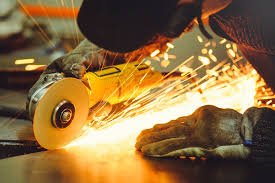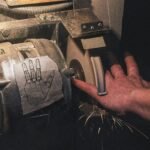Understanding Angle Grinders
An angle grinder, often referred to as a side grinder or disc grinder, is a versatile power tool used for grinding, cutting, and polishing various materials. Typically powered by either electricity or compressed air, it features a rotating disc that spins at high speeds, allowing the user to perform a myriad of tasks efficiently. The design and operation of angle grinders make them invaluable tools in construction, metalworking, and DIY projects. Their ability to handle tough materials such as metal, tile, and masonry has cemented their status as a must-have for both professionals and hobbyists.
Angle grinders come in different types, categorized mainly by their power source. The most common types include electric corded grinders and battery-operated models, each offering unique advantages. Electric grinders provide continuous power and are often used for longer tasks, while cordless versions offer mobility and convenience for jobs where a power outlet is not readily available. Furthermore, angle grinders can differ in size and disc diameter, which impacts their usability in various applications.
The main components of an angle grinder include the motor, gear housing, handle, safety guard, and the disc itself. The motor drives the spindle, which rotates the disc at high speeds. The safety guard is essential for protecting the user from debris and sparks generated during operation. Handles can be positioned in various ways to ensure secure grip and stability during use. Additionally, users can easily change out discs based on the task at hand, whether it’s cutting through metal, grinding surface materials, or polishing surfaces.
In essence, understanding angle grinders involves more than just recognizing their physical attributes; it requires knowledge of their functional versatility. From cutting rebar on job sites to polishing metal surfaces in workshops, angle grinders adapt effortlessly to countless tasks, proving to be indispensable tools in various fields.
Key Features to Consider
When purchasing an angle grinder, understanding the essential features can greatly influence your decision and ensure you select the best tool for your needs. One of the most critical components to evaluate is the motor power, typically measured in watts. Higher motor power indicates a more robust performance, enabling the grinder to tackle tougher materials like metal and concrete effectively. A grinder with a motor power of 6 to 15 amps is commonly preferred, with higher amperage equating to greater efficiency in demanding tasks.
Another vital aspect is the speed, often represented in revolutions per minute (RPM). Different tasks accommodate varying speeds; for instance, higher RPM is beneficial for polishing and grinding metal, while lower RPM settings can be more appropriate for cutting purposes. Choosing a model with adjustable speed settings allows users to perform a wider range of applications with precision.
The wheel size is also worth considering, as it determines the grinder’s versatility and suitability for specific tasks. Common wheel sizes range from 4.5 inches to 9 inches, with larger wheels generally providing faster cutting capabilities and deeper cuts. However, smaller wheels offer better control and are ideal for more detailed work.
Weight plays a significant role in usability and comfort during prolonged use. A lighter grinder can offer better maneuverability, reducing fatigue during extensive projects, while a heavier model might provide enhanced stability. Ergonomics should not be overlooked; tools designed with comfort grips and adjustable handles significantly improve the user experience, minimizing the risk of hand strain.
Incorporating these features into your evaluation will ensure that the angle grinder you choose not only meets your current requirements but also adapts to various tasks, maximizing efficiency and safety.
Types of Angle Grinders

Angle grinders are versatile tools utilized for various tasks including cutting, grinding, and polishing. They come in several types, each tailored to meet specific needs based on power source and intended use. The most common types are corded, cordless, pneumatic, and specialized models.
Corded angle grinders are powered directly through an electrical outlet, providing consistent power and performance. They are particularly suitable for heavy-duty tasks, as they generally offer higher power ratings and longer operational time without the need to recharge or replace batteries. This makes them ideal for workshop environments where a continuous power supply is available.
On the other hand, cordless angle grinders offer the advantage of portability and convenience. These battery-operated models enable users to easily work in remote locations without the hassle of dealing with cords. While they have improved significantly in power and runtime, they may be less powerful than their corded counterparts, particularly when tackling heavy-duty projects. Nevertheless, for light to moderate tasks, a cordless grinder can be an efficient and flexible choice.
Pneumatic angle grinders operate using compressed air, making them an excellent option for professional environments such as automotive or manufacturing industries. They tend to be lighter and provide a high power-to-weight ratio. However, they require an air compressor to function, which can limit mobility unless properly set up with an air line.
Additionally, there are specialized models built for specific applications like angle polishing or grinding with unique accessories. These specialized grinders tend to focus on performance attributes tailored to specific tasks, ensuring optimal results. Ultimately, selecting the right type of angle grinder depends on the intended applications and work environment, enabling buyers to make informed decisions that suit their needs best.
Choosing the Right Wheel and Accessories
When procuring an angle grinder, one of the paramount considerations is selecting the appropriate grinding wheels and accessories tailored to specific applications. The type of wheel significantly influences the grinder’s performance, efficiency, and the quality of the finish achieved. Various grinding wheels are designed for distinct tasks such as cutting, grinding, and polishing, each necessitating a unique material and structure to optimize results.
For cutting applications, a thin-cutting wheel is generally preferred as it minimizes material loss and provides precise cuts. These wheels are commonly composed of aluminum oxide or zirconia, ensuring durability and strength. For grinding tasks, a thicker grinding wheel is typically used, which allows for more aggressive material removal, making it ideal for shaping and smoothing surfaces. Such wheels also come in different grades, influencing the rate of material removal as well as the finish achieved.
Polishing actions require specific buffing wheels or pads, usually made from softer materials that are designed to enhance shine without scratching the surface. Using the incorrect wheel can lead to undesirable results, jeopardizing the task’s effectiveness while posing safety risks, such as wheel breakage. Therefore, it is vital to review the wheel’s specifications, including its intended use, diameter, thickness, and compatibility with the grinder.
Furthermore, safety considerations must not be overlooked when selecting wheels and accessories. Each wheel has a maximum RPM rating; it is crucial to match this with the angle grinder’s operating speed. Additionally, always use protective gear, such as goggles and gloves, while operating an angle grinder. By ensuring the correct wheel selection and adhering to safety protocols, users can maximize the tool’s performance and mitigate potential hazards.
Safety Features to Look For
When operating an angle grinder, prioritizing safety is essential to prevent accidents and injuries. Understanding the key safety features can significantly enhance user protection during operation. One primary safety feature to consider is the presence of guards. The guard acts as a shield between the user and the grinder’s rotating disc, effectively preventing debris and sparks from causing harm. Adjustable guards can provide added flexibility, allowing users to position them appropriately based on the specific grinding task at hand.
Another critical feature is the trigger mechanism. Many modern angle grinders are equipped with a safety trigger that requires a deliberate action to engage, minimizing the risk of accidental starts. This feature is essential in maintaining control, especially in high-tension situations. Additionally, a lock-on switch can provide continuous power while reducing hand fatigue. However, it is crucial to ensure that such switches have a safety mechanism to prevent unintentional activation.
Anti-vibration systems are also important as they enhance comfort and control during extended use. Vibration can lead to hand fatigue and ultimately result in loss of control over the tool. Look for grinders designed with rubberized grips and built-in anti-vibration technology, which can help mitigate these effects. Furthermore, safety cut-off switches play a vital role in emergency situations, allowing users to quickly power down the tool if needed.
Incorporating these safety features into your choice of angle grinder can significantly improve operational safety. It is advisable to thoroughly evaluate these attributes when selecting a tool to ensure a secure working environment, maintaining both efficiency and user well-being during all grinding tasks.
Budget Considerations: Finding Value for Money
When setting a budget for purchasing an angle grinder, it is crucial to consider the price range that aligns with the specific features and quality you desire. Angle grinders are available in various price categories, typically falling into three distinct tiers: budget, mid-range, and premium models. Each of these categories comes with its unique set of features, performance capabilities, and expected longevity, which should be weighed against your personal needs and intended usage.
In the budget category, you can expect to pay around $30 to $80 for basic models. These angle grinders generally offer reduced features and power but can still be suitable for light-duty tasks such as hobby projects or simple home repairs. If you are a DIY enthusiast looking for an entry-level tool, a model within this price range may meet your needs without straining your finances.
Mid-range angle grinders, typically priced between $80 and $150, provide a comprehensive balance of performance and durability. These models often come equipped with more powerful motors, higher RPMs, and enhanced safety features. They cater well to seasoned DIYers and small professionals who may require the grinder for regular use in projects or repairs but don’t need the advanced capabilities of a high-end model.
For professionals or avid users, investing in a premium angle grinder, ranging from $150 to $500 and above, may be essential. High-end models often feature robust construction, extended warranties, exceptional power, and various advanced functionalities, such as variable speed settings and dust extraction capabilities. While the upfront cost is significantly higher, these tools typically provide better performance and longevity, delivering superior value for professionals who rely on their equipment for daily tasks.
Ultimately, achieving value for money requires careful consideration of your specific needs against the budget you set. It is recommended to assess how often you will use the grinder, the types of materials you’ll work with, and potential future projects before making a decision. By approaching your purchase with a clear understanding of budget considerations and the relationship between price and performance, you can ensure that you secure an angle grinder that offers excellent value for your investment.
Brand Reputation and Reliability
When investing in an angle grinder, one critical factor that cannot be overlooked is the brand reputation and reliability of the manufacturer. Recognized brands often have a long-standing history of producing durable and high-quality tools. These companies invest in research and development to ensure their products not only perform effectively but also meet safety standards. A reputable brand is usually synonymous with trust, ensuring that consumers receive products built to last.
To make an informed decision, it is advisable to conduct thorough research into a brand’s history and market presence. Brands that have been in the industry for years often have proven track records and have continuously focused on improving their products. Investigating the brand’s commitment to customer service can also yield insights into their reliability; brands that prioritize customer satisfaction often respond swiftly to any issues that arise with their tools.
Reading customer reviews is another essential component in evaluating brand reliability. Reviews on retailer websites, specialized forums, and social media platforms can offer a wealth of information regarding users’ experiences with specific angle grinder models. Look for consistent positive feedback concerning performance, durability, and customer service. It is also helpful to pay attention to negative reviews and any trends that may signal recurring issues with particular models or brands.
Additionally, understanding warranty conditions is vital when selecting a brand. A good warranty reflects a company’s confidence in its product and offers customers peace of mind. Reliable brands typically provide extended warranty periods and easy claims processes, which enhance the overall purchasing experience. By examining brand reputation, user reviews, and warranty terms, consumers can select an angle grinder that not only meets their immediate needs but also stands the test of time, ensuring satisfaction with their investment.
User Reviews and Expert Recommendations
When it comes to purchasing an angle grinder, user reviews and expert recommendations play a pivotal role in guiding buyers toward making informed choices. These insights provide invaluable information about the performance and reliability of various models, showcasing real-world experiences and expert evaluations. To optimize the decision-making process, it is crucial to know where to find credible reviews and how to interpret them effectively.
One of the best places to find user reviews is on specialized hardware and tool websites, as well as retailers like Amazon and Home Depot. These platforms often feature customer feedback that can help potential buyers gauge the effectiveness of an angle grinder in various applications. Similarly, forums and social media groups dedicated to tool enthusiasts can be sources of genuine opinions. However, it is important to consider the overall consensus rather than focusing on outlier reviews that might be overly positive or negative.
As for expert recommendations, industry publications and websites often provide in-depth reviews and comparisons of angle grinders. These sources typically assess the technical specifications, build quality, and user-friendliness of each model. Experts often conduct rigorous testing under controlled conditions, which can reveal insights into the durability and overall performance that casual users might overlook.
When interpreting both user and expert reviews, it is essential to look beyond the ratings and examine the context. For example, consider the user’s experience level and the specific tasks they perform with the tool. A professional contractor and a DIY enthusiast may have vastly different expectations and needs, affecting their reviews. By synthesizing insights from multiple sources, buyers can develop a well-rounded understanding of which angle grinder best fits their requirements.
Final Thoughts: Making the Right Choice
When it comes to purchasing an angle grinder, it is essential to carefully consider various factors to ensure that you make the right choice tailored to your specific needs. Throughout this guide, we have explored critical aspects that should influence your decision-making process, including the type of angle grinder, power source, size, and accessories. Each of these elements plays a significant role in maximizing the potential of your angle grinder while effectively meeting the demands of your projects.
First and foremost, you should identify the primary tasks that you intend to accomplish with your angle grinder. Whether you require a tool for metal fabrication, tile cutting, or woodworking, it is important to select a model equipped with the proper specifications. For instance, a higher RPM is advantageous for metalworking applications, while a lower RPM may be more suitable for tasks requiring greater precision, such as cutting tiles. Understanding these nuances will help you select a grinder that aligns with your intended uses.
Moreover, it is crucial to factor in ergonomics, especially if you expect to use the tool for extended periods. A lightweight design, comfortable grip, and adjustable handles can enhance usability and reduce fatigue during operation. While it may be tempting to choose the most powerful angle grinder on the market, higher wattage does not always equate to better performance. The correct match between the tool’s capabilities and your personal requirements is vital.
Lastly, considering budget constraints and brand reliability contributes to a satisfactory purchase experience. Investing in a reputable brand often translates to better customer service and product longevity, making it a worthwhile consideration. By synthesizing these factors, you will be well-prepared to make an informed choice, ultimately leading to more successful outcomes in your projects involving this versatile tool.

